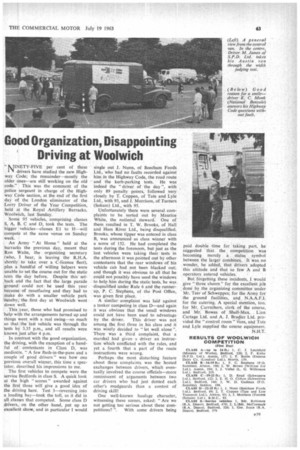Good Organization, Disappointing Driving at Woolwich
Page 65

If you've noticed an error in this article please click here to report it so we can fix it.
" MINETY-FIVE per cent of these drivers have studied the new Highway Code; the remainder—mostly the older ones—are still working on the old code." This was the comment of the police sergeant in charge of the Highway Code section, at the end of the first day of the London eliminator of the Lorry Driver of the Year Competition, held at the Royal Artillery Barracks, Woolwich, last Sunday.
Some 95 vehicles, comprising classes S, A, B, C and D, took the tests. The bigger vehicles—classes El to H—will compete at the same venue on Sunday week.
An Army "At Home" held at the barracks the previous day, meant that Ron Waite, the organizing secretary (who, I hear, is leaving the R.H.A. shortly to take over a C-licence fleet), plus a handful of willing helpers were unable to set the course out for the static tests the day before. Despite this setback and the fact that the large parade ground could not be used this year because of resurfacing and they had to make do with a smaller vehicle park nearby, the first day at Woolwich went down well.
This year, those who had promised to help with the arrangements turned up and things went with a real swing—so much so that the last vehicle was through the tests by 3.35 pin., and all results were known just after 4 p.m.
In contrast with the good organization, the driving, with the exception of a handful of contestants in Class D, was mediocre. "A few flash-in-the-pans and a couple of good drivers" was how one previous overall winner, this time a spectator, described his impressions to me.
The first vehicles to compete were the service I3edfords in class S. A quick look at the high " scores " awarded against the first three will give a good idea of the driving here. Test 3—reversing into a loading bay—took the toll, as it did in all classes that competed. Some class D drivers, on the other hand, put up an excellent show, and in particular I would single out J. Nunn, of Beecham Foods Ltd., who had no faults recorded against him in the Highway Code, the road route and the kerb-parking tests. He was indeed the "driver of the day ", with only 89 penalty points, followed very closely by T. Coppen, of Tate and Lyle Ltd., with 93, and J. Morrison, of Turners (Soham) Ltd., with 95.
Unfortunately there were several complaints to be sorted out by Maurice White, the national steward. One of them resulted in T. W. Brooks, of Hall and Ham River Ltd., being disqualified. Brooks, whose tipper was entered in class B, was announced as class winner with a score of 152. He had completed the tests during the forenoon, but just as the last vehicles were taking their tests in the afternoon it was pointed out by other contestants that the rear windows of his vehicle cab had not been blacked out; and though it was obvious to all that he could not possibly have used the windows to help him during the static tests, he was disqualified under Rule 6 and the runnerup, P. C. Stephens, of the Post Office, was given first place.
A similar complaint was laid against a tanker competing in class D—and again it was obvious that the small windows could not have been used to advantage by the driver. This driver was not among the first three in his class and it was wisely decided to 'let well alone". There was a third complaint, that a marshal had given a driver an instruction which conflicted with the rules, and yet a fourth that a part of the route instructions were wrong.
Perhaps the most disturbing feature about these complaints was the heated exchanges between drivers, which eventually involved the course officials—more reminiscent of arguments between two car drivers who had just dented each other's mudguards than a contest of driving skill!
One well-known haulage character, witnessing these scenes, asked: "Are we not getting too serious about these com petitions? ". With some drivers being paid double time for taking part, he suggested that the competition Was becoming merely a status symbol between the larger combines. It was no wonder, he added, that drivers adopted this attitude and that so few A and B operators entered vehicles.
But forgetting these incidents, I would give " three cheers for the excellent job done by the organizing committee under Mr. Teer of Schweppes; for the Arm)' for the ground facilities, and N.A.A.F.I, for the catering. A special Mention, too, for Mr. Carruthers, clerk of the course, and Mr. Bowes of Shell-Mex. Lion Cartage Ltd. and A. J. Bradier Ltd. provided the "control room" Nians, and Tate and Lyle supplied the course equipment.
N.H.T.




















































































































